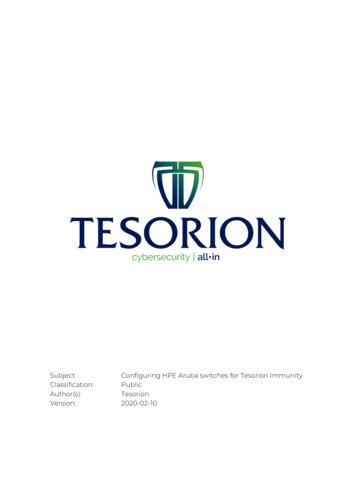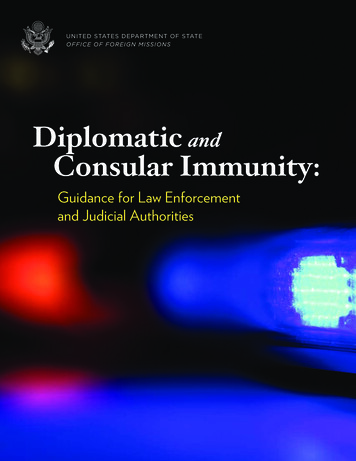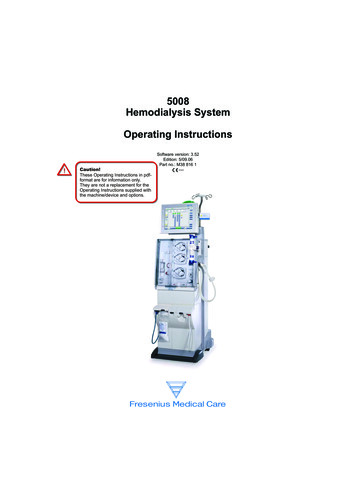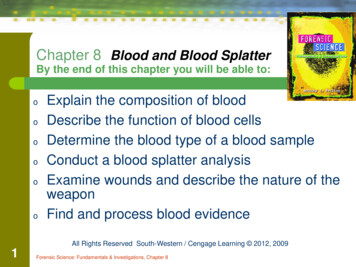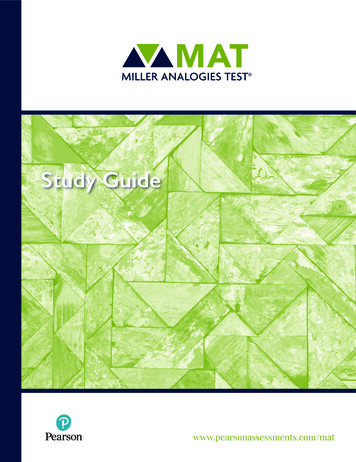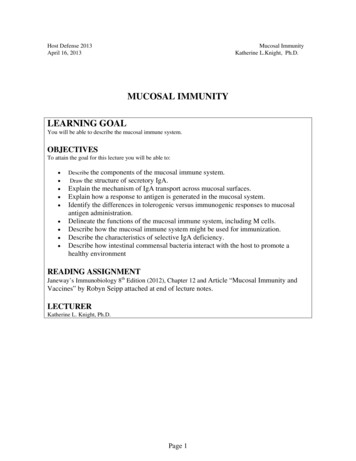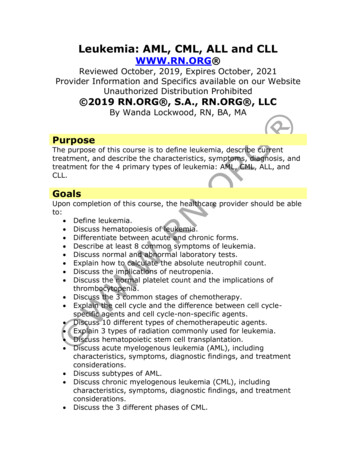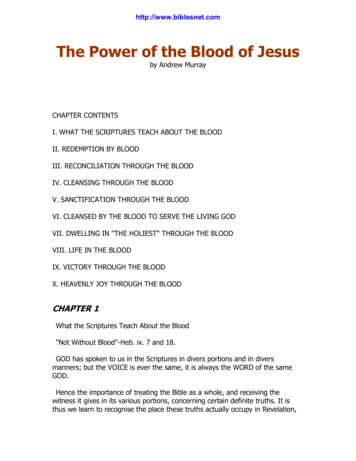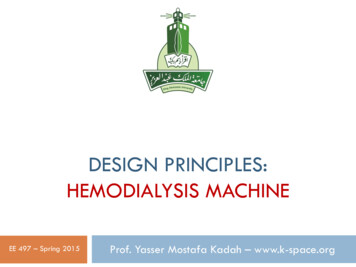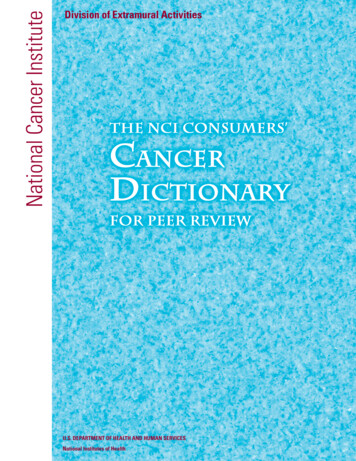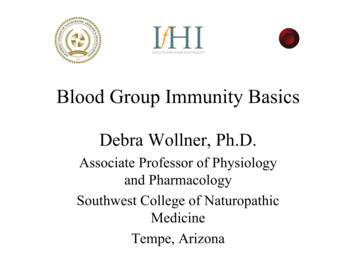
Transcription
Blood Group Immunity BasicsDebra Wollner, Ph.D.Associate Professor of Physiologyand PharmacologySouthwest College of NaturopathicMedicineTempe, Arizona
Introduction to blood types Specific molecules on the surfaces of red bloodcells– Recognition signals It’s long been known– Can sometimes mix blood from different patients– But sometimes mixing blood leads to a fatal response 1901, Carl Landsteiner reported the existence ofblood types Blood type determination ensures that mixing ofthe same type of blood is okay Incorrectly mixed blood will agglutinate
Agglutination of blood Due to the presence of antibodies in serum Antibodies can attach to antigens on redblood cell (rbc) surface Antibodies cause clumping, oragglutination, of improperly typed rbcs– Properly typed blood will not agglutinate
Agglutination of erythrocytes http://vtpb-www.cvm.tamu.edu/vtpb/vet micro/serology/aggl/diagram.html
Blood typing principles- ABO Type A has O antigen and A antigen– Can receive A or O type blood– Can donate to A or AB type recipient Type B has O antigen and B antigen– Can receive B or O type blood– Can donate to B or AB type recipient Type AB has O, A and B antigens– Can receive any type blood– Can donate only to type AB recipient Type O has only O antigen– Can receive only type O blood– Can donate to any recipient
What determines blood type? Presence of antigens on surface of red bloodcells Same blood type antigen is found on manycells throughout the body Same blood type antigen may be secretedinto body fluids– secretors
Structures of the ABO bloodtype antigens Lodish, et al., Molecular Cell Biology, 4/e, 2000, W.H. Freeman
Antigens An antigen is a molecule that can stimulatean immune response– The ‘A’ antigen does not behave as an antigenin a blood type A person Immune responses are mediated by theimmune system
Why do we generate an immuneresponse against blood typeantigens? The antigens found on red blood cells– Also found on other body cells– Also found in foreign substances Exposure to a substance with an antigen willstimulate an immune response Blood type A will not generate a response againstantigen A or O– Will respond to an antigen that looks like B antigen Blood type B will not generate a response againstantigen B or O– Will respond to an antigen that looks like A antigen
Immune system Cells that have the ability to recognizeforeign substances The cells of the immune system help thebody neutralize and dispose of foreignsubstances
Parts of the immune system Barrriers– Epithelium, mucosa, secretions– Act to prevent foreign substances from entering thebody– Non-specific Cells– Lymphocytes– T and B cells– Highly specific Antibodies– Produced by the B cells
Immunity Specificity– Recognition of a wide variety of antigens– Determines ‘Self’ vs ‘non-self’– Acts to remove non-self antigens from the body
Bone marrowstem cells Stem cells can developinto a variety of cells Stem cells in the bonemarrow can develop intoany of the blood cells– Including immune cells une08.htmArtwork originally created forthe National Cancer Institute.Reprinted with permission ofthe artist, Jeanne Kelly.Copyright 1996
What stimulates an immuneresponse? Foreign antigen Engulfed by macrophage Macrophage presentsantigen pieces to helper Tcell Mature helper T cell thenhelps develop the immuneresponse une08.htm
Specificity of immune response Only the helper T cells that recognizes theantigen is stimulated The specific T cell then divides into more Tcells– clones Now the body has many identical helper Tcells that recognize a given foreign antigen
Helper T cells Helper T cells stimulate B cells– Only the specific B cell that recognizes anantigen B cells divide B cells secrete antibodies Antibodies immobilize and agglutinateantigen
Production of antibodies Helper T cellsstimulate B cells B cells become plasmacells Secrete antibodies une08.htm
Antibodies Immunoglobulins (Ig’s)– Proteins that recognizeantigens– Will bind antigens– Clumps groups of antigentogether for easier disposal Agglutination reaction Different classes ofantibodies Variable regions bind tospecific antigen une08.htm
ImmunoglobulinIgG Two binding sites– variable regions– Recognize antigen Constant region Binds two antigens Immobilizes them forremoval bymacrophages Immunobiology. 5th ed.Janeway, et al. 2001, GarlandPublishing
Immunoglobulinstructure IgM has a pentamericstructure– Used in blood typing IgA has a dimericstructure– Found in secretions Immunobiology. 5th ed.Janeway, et al. 2001, GarlandPublishing
Immunoglobulin E Associated with thesurface of mast cells Mediates allergic reactions When allergen binds, themast cells releasehistamine Immunobiology. 5th ed.Janeway, et al. 2001, GarlandPublishing
Destruction of altered or foreigncells Complement Cytotoxic T cells Bind and recognizeantigen on the surfaceof cells Begin process that willdestroy the altered cell Immunobiology. 5th ed.Janeway, et al. 2001, GarlandPublishing
Blood type antigen Provide recognition to the immune system– Found on many body cells Immune system will not attack cells withthe matching blood type antigen Derangements in blood type antigen– Can occur in cancer– Can assist immune system in recognizing anddestroying the cancer cells
Blood type antigen RecognitionAdhesionCells of organs need to stick togetherTumor cells- antigens may be derangedLack of adhesion– Leads to metastasis
Lectins Proteins that bind to carbohydrates– specificity Lectins are found in foods– Wheat germ agglutinen– Adheres to nAcetyl-glucosamine– Glues bread dough together Lectins are found on the surfaces of someMicrobes
Microbial lectins Microbes have lectins on their surfaces– Aids in attachment of microbes to epithelial surfaces– Microbes will bind to cells that express theircarbohydrate receptor– May be blood type carbohydrate Many associations between specific blood typeand susceptibility to certain microbial infections
Microbial specificity Blood type B tends to be disposed spneumonia Blood type A tends to be disposed to– Otitis media– Giardia Blood type O tends to be disposed to––––Helicobacter pyloriCandida albicansCholeraYersinia (plague)
Microbial specificity Blood type O tends to be protected from– Diphtheria– Typhoid
Plant (and other food) lectins Some lectins in foods can cause problems tocertain blood types Some lectins may be protective– May compete with harmful lectins for adhesionto cell surfaces– May Inhibit the attachment of microbes toepithelial surfaces
Blood types ABH/OSecretor/non-secretorLewis antigenRhesus antigen
Blood type antigen Defined set of carbohydrates– Simple sugars attached in certain orders Galactose on the end specifies B nAcetylgalactosamine on the end - A No sugar in the end position specifies O
ABO blood type antigens Lodish, et al., Molecular Cell Biology, 4/e, 2000, W.H. Freeman
Glucose One simple sugar Composed of– Carbon– Hydrogen– oxygen Carbohyrate est/testF/gluStr.html
Cell surface carbohydrates Found on all cell surfaces Blood type antigen is found on many cellsurfaces Provide recognition between cells Provide a surface to interact with the world Carbohydrates face into the intestine– Interact with foods and microbes
ABO blood type Blood type present on outside of cell– Attached to the membrane of the red blood cell– Attached to proteins on the surface of otherbody cells– On the outside of intestinal epithelial cells Directed to the inside of the intestines Faces toward the food
Blood type antigen On epithelial surfaces– Available for microbes to bind Microbes specifically interact withepithelial surface receptor– Some of these are the blood type antigen
Secretor 80% are secretors– Secreted blood type antigen– Into body secretions TearsGI tractMilkSaliva
Benefits of secretion of antigen Secreted antigen can bind lectins insecretions May be able to inhibit lectin binding toepithelium May reduce the binding of microbes to theepithelium
Lewis Similar to ABO blood groups Found on the surface of leukocytes Lewis antigens are important ininflammation––––Help with cell recognitionLeukocytes leave the blood plasmaMove to the tissues in inflammationLewis antigen promotes this movement
Lewis antigen Found in the red blood cell– Lewis antigen is synthesized in other cells– Moves to the red blood cell– Attached through lipids Can unattach, not a permanent antigen inrbcs
Rhesus Another antigen found on red blood cells Originally found in rhesus monkeys Associated with erythroblastosis fetalis––––Rh fetus borne by Rh- motherIncompatibleMother’s immune system will attack the fetusUsually second birth
Rhesus antigen incompatibility Only a problem in Rh- mothers Only when father is Rh – Some of the offspring may be Rh First birth is usually ok– Mother’s immune system is sensitized Subsequent births are at risk Treated with Rhogam– 7 months and at birth Can inhibit maternal immune response to Rhantigen
Summary Blood type antigens are on the surfaces ofmany body cells Help with recognition of cells– Movement of cells through body– Immune system self recognition Interact with food lectins Interact with microbial lectins
Immunobiology. 5th ed. Janeway, et al. 2001, Garland Publishing. Blood type antigen Provide recognition to the immune system - Found on many body cells Immune system will not attack cells with the matching blood type antigen Derangements in blood type antigen
